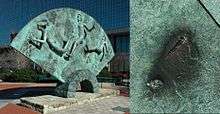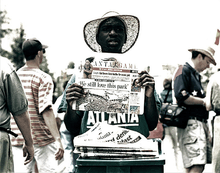Centennial Olympic Park bombing
| Centennial Olympic Park Bombing | |
|---|---|
 Bomb fragment mark on Olympic Park sculpture | |
| Location | Atlanta, Georgia, United States |
| Coordinates | 33°45′38″N 84°23′33″W / 33.76065°N 84.392583°WCoordinates: 33°45′38″N 84°23′33″W / 33.76065°N 84.392583°W |
| Date |
July 27, 1996 1:20 am (UTC-4) |
| Target | Centennial Olympic Park |
Attack type | Bombing |
| Weapons | Pipe bomb |
| Deaths | 2 (1 from heart attack) |
Non-fatal injuries | 111 |
| Perpetrators |
Eric Robert Rudolph Army of God |
The Centennial Olympic Park bombing was a domestic terrorist pipe bombing attack on the Centennial Olympic Park in Atlanta, Georgia, on July 27 during the 1996 Summer Olympics. The blast directly killed 1 person and injured 111 others; another person later died of a heart attack. It was the first of four bombings committed by Eric Robert Rudolph.[1] Security guard Richard Jewell discovered the bomb before detonation and cleared most of the spectators out of the park. Rudolph, a carpenter and handyman, had detonated three pipe bombs inside a U.S. military ALICE Pack. Motivated by what he considered to be the government's sanctioning of "abortion on demand," Rudolph wanted to force the cancellation of the Olympics.
After the bombings, Jewell was falsely implicated as a suspect by the Federal Bureau of Investigation and the news media focused aggressively on him as the presumed culprit. However, in October 1996, Jewell was exonerated when the FBI declared that he was no longer a person of interest. Following three more bombings in 1997, Rudolph was identified by the FBI as the suspect. In 2003, Rudolph was arrested and tried before being convicted two years later. Rudolph was sentenced to life imprisonment without parole for his crimes.
Bombing
Centennial Olympic Park was designed as the "town square" of the Olympics, and thousands of spectators had gathered for a late concert by the band Jack Mack and the Heart Attack. Sometime after midnight, Rudolph planted a green U.S. military ALICE pack (field pack) containing three pipe bombs surrounded by three-inch-long (7.6 cm) masonry nails, which caused most of the human injuries, underneath a bench near the base of a concert sound tower. He then left the area. The pack had a directed charge and could have done more damage but it was slightly moved at some point.[2] It used a steel plate as a directional device.[3] Investigators would later tie the Sandy Springs and Otherside bombs together with this first device because all were propelled by nitroglycerin dynamite, used an alarm clock and Rubbermaid containers, and contained steel plates.[4]
The sound of the explosion was recorded by a news crew from the German public television network ARD, who were interviewing American swimmer Janet Evans at a nearby hotel.[5][6]
Security guard Richard Jewell discovered the bag and alerted Georgia Bureau of Investigation officers. Jewell and other security guards began clearing the immediate area so that a bomb squad could investigate the suspicious package. The bomb detonated before all spectators could leave the area.
Alice Hawthorne, 44, of Albany, Georgia, was killed in the explosion when a nail from the bomb penetrated her skull. A Turkish cameraman of Turkish Radio and Television Corporation, Melih Uzunyol, 40, had a fatal heart attack while running to the scene.[7] The bomb wounded 111 others.
Reaction

President Bill Clinton denounced the explosion as an "evil act of terror" and vowed to do everything possible to track down and punish those responsible.[8]
Despite the event, officials and athletes agreed that the games should continue as planned.
Aftermath
Richard Jewell falsely implicated
Though Richard Jewell was hailed as a hero for his role in discovering the bomb and moving spectators to safety, news organizations later reported that Jewell was considered a potential suspect in the bombing, four days afterward, and shortly after a brief, mistaken detainment of two juvenile persons of interest at the Kensington MARTA station. Jewell, at the time, was unknown to authorities, and a lone wolf profile made sense to FBI investigators after being contacted by his former employer at Piedmont College.
Jewell was named as a person of interest, although he was never arrested. Jewell's home was searched and his background exhaustively investigated and he became the subject of intense media interest and surveillance, including a media siege of his home.[2]
After Jewell was exonerated, he initiated defamation lawsuits against NBC News, The Atlanta Journal-Constitution, and other media entities, and insisted on a formal apology from them. Jewell's lawsuit accused Piedmont College President Raymond Cleere of falsely describing Jewell as a "badge-wearing zealot" who "would write epic police reports for minor infractions."[9]
Conviction of Eric Robert Rudolph
After Jewell was cleared, the FBI admitted it had no other suspects, and the investigation made little progress until early 1997, when two more bombings took place at an abortion clinic and a lesbian nightclub, both in the Atlanta area. Similarities in the bomb design allowed investigators to conclude that this was the work of the same perpetrator. One more bombing of an abortion clinic, this time in Birmingham, Alabama, which killed a policeman working as a security guard and seriously injured nurse Emily Lyons, gave the FBI crucial clues including a partial license plate.
The plate and other clues led the FBI to identify Eric Robert Rudolph as a suspect. Rudolph eluded capture and became a fugitive; officials believed he had disappeared into the rugged southern Appalachian Mountains, familiar from his youth. On May 5, 1998, the FBI named him as one of its ten most wanted fugitives and offered a $1,000,000 reward for information leading directly to his arrest. On October 14, 1998, the Department of Justice formally named Rudolph as its suspect in all four bombings.
After more than five years on the run, Rudolph was arrested on May 31, 2003, in Murphy, North Carolina, by a rookie police officer, Jeffrey Scott Postell of the Murphy Police Department behind a Save-A-Lot store at about 4 a.m.; Postell, on routine patrol, had originally suspected a burglary in progress.[10]
On April 8, 2005, the government announced Rudolph would plead guilty to all four bombings, including the Centennial Olympic Park attack.
Rudolph is serving four life terms without the possibility of parole at ADX Florence supermax prison in Florence, Colorado.
Rudolph's justification for the bombings according to his April 13, 2005 statement, was political:[11]
- In the summer of 1996, the world converged upon Atlanta for the Olympic Games. Under the protection and auspices of the regime in Washington millions of people came to celebrate the ideals of global socialism. Multinational corporations spent billions of dollars, and Washington organized an army of security to protect these best of all games. Even though the conception and purpose of the so-called Olympic movement is to promote the values of global socialism, as perfectly expressed in the song Imagine by John Lennon, which was the theme of the 1996 Games even though the purpose of the Olympics is to promote these ideals, the purpose of the attack on July 27 was to confound, anger and embarrass the Washington government in the eyes of the world for its abominable sanctioning of abortion on demand.
- The plan was to force the cancellation of the Games, or at least create a state of insecurity to empty the streets around the venues and thereby eat into the vast amounts of money invested.
On August 22, 2005, Rudolph, who had previously received a life sentence for the Alabama bombing, was sentenced to three concurrent terms of life imprisonment without parole for the Georgia incidents. Rudolph read a statement at his sentencing in which he apologized to the victims and families only of the Centennial Park bombing, reiterating that he was angry at the government and hoped the Olympics would be canceled. At his sentencing, fourteen other victims or relatives gave statements, including the widower of Alice Hawthorne.
As reported in an April 8, 2013, Alabama blog,[12] in February 2013, LuLu.com published Rudolph's book, Between the Lines of Drift: The Memoirs of a Militant, and in April 2013 the U.S. Attorney General seized his $200 royalty to help pay off the $1 million that Rudolph owes in restitution to the state of Alabama.
See also
- Munich massacre
- Domestic terrorism in the United States
- Boston Marathon bombings, another bombing at an American sporting event
References
- ↑ Gross, Doug (April 14, 2005). "Eric Rudolph Lays Out the Arguments that Fueled His Two-Year Bomb Attacks". San Diego Union-Tribune. Associated Press.
- 1 2 Brenner, Marie (February 1997). "American Nightmare: The Ballad of Richard Jewell". Vanity Fair. Retrieved December 6, 2013.
- ↑ Brown, Aaron & Harris, Art (February 7, 2001). "The Hunt for Eric Rudolph". CNN Presents. CNN. Retrieved December 6, 2013.
- ↑ Freeman, Scott (August 24, 2006). "A Hero In His Own Mind". Orlando Weekly. Retrieved December 6, 2013.
- ↑ "JANET EVANS NEARBY DURING CENTENNIAL PARK EXPLOSION". Deseret News / Associated Press. 27 July 1996. Retrieved 12 August 2016.
- ↑ Mackay, Duncan. "Janet Evans to return to Atlanta as part of 20th anniversary celebrations for 1996 Olympics". Inside the Games. Retrieved 12 August 2016.
- ↑ Jacobs, Jeff (July 28, 1996). "In Atlanta, Fear Roams Hand In Hand With Anger". Hartford Courant.
- ↑ "Clinton Pledges Thorough Effort to Find Olympic Park Bomber". CNN. July 27, 1996. Retrieved December 6, 2013.
- ↑ "Ex-Suspect in Bombing Sues Newspapers, College: Jewell's Libel Claim Seeks Unspecified Damages". The Washington Post. January 29, 1997. Retrieved December 6, 2013 – via Highbeam Research.
- ↑ "Atlanta Olympic Bombing Suspect Arrested". CNN. May 31, 2003.
- ↑ "Full Text of Eric Rudolph's Confession". NPR (National Public Radio). April 14, 2005. Retrieved December 6, 2013.
- ↑ Faulk, Kent (April 8, 2013). "Birmingham Abortion Clinic Bomber Eric Robert Rudolph Fights to Get Profits from His Book". AL.com.
External links
- FBI Centennial Park Bombing page via the Wayback Machine, from December 2, 1998